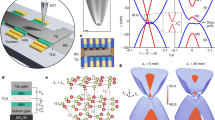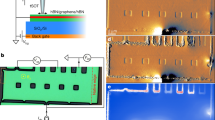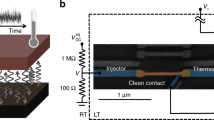Abstract
Energy dissipation is a fundamental process governing the dynamics of physical, chemical and biological systems. It is also one of the main characteristics that distinguish quantum from classical phenomena. In particular, in condensed matter physics, scattering mechanisms, loss of quantum information or breakdown of topological protection are deeply rooted in the intricate details of how and where the dissipation occurs. Yet the microscopic behaviour of a system is usually not formulated in terms of dissipation because energy dissipation is not a readily measurable quantity on the micrometre scale. Although nanoscale thermometry has gained much recent interest1,2,3,4,5,6,7,8,9,10,11,12,13,14,15, existing thermal imaging methods are not sensitive enough for the study of quantum systems and are also unsuitable for the low-temperature operation that is required. Here we report a nano-thermometer based on a superconducting quantum interference device with a diameter of less than 50 nanometres that resides at the apex of a sharp pipette: it provides scanning cryogenic thermal sensing that is four orders of magnitude more sensitive than previous devices—below 1 μK Hz−1/2. This non-contact, non-invasive thermometry allows thermal imaging of very low intensity, nanoscale energy dissipation down to the fundamental Landauer limit16,17,18 of 40 femtowatts for continuous readout of a single qubit at one gigahertz at 4.2 kelvin. These advances enable the observation of changes in dissipation due to single-electron charging of individual quantum dots in carbon nanotubes. They also reveal a dissipation mechanism attributable to resonant localized states in graphene encapsulated within hexagonal boron nitride, opening the door to direct thermal imaging of nanoscale dissipation processes in quantum matter.
This is a preview of subscription content, access via your institution
Access options
Subscribe to this journal
Receive 51 print issues and online access
$199.00 per year
only $3.90 per issue
Buy this article
- Purchase on Springer Link
- Instant access to full article PDF
Prices may be subject to local taxes which are calculated during checkout



Similar content being viewed by others
References
Yue, Y. & Wang, X. Nanoscale thermal probing. Nano Rev. 3, 11586 (2012).
Giazotto, F., Heikkilä, T. T., Luukanen, A., Savin, A. M. & Pekola, J. P. Opportunities for mesoscopics in thermometry and refrigeration: physics and applications. Rev. Mod. Phys. 78, 217–274 (2006).
Jin, C. Y., Li, Z., Williams, R. S., Lee, K. C. & Park, I. Localized temperature and chemical reaction control in nanoscale space by nanowire array. Nano Lett. 11, 4818–4825 (2011).
Kucsko, G. et al. Nanometre-scale thermometry in a living cell. Nature 500, 54–58 (2013).
Mecklenburg, M. et al. Nanoscale temperature mapping in operating microelectronic devices. Science 347, 629–632 (2015).
Teyssieux, D., Thiery, L. & Cretin, B. Near-infrared thermography using a charge-coupled device camera: application to microsystems. Rev. Sci. Instrum. 78, 034902 (2007).
Toyli, D. M., de las Casas, C. F., Christle, D. J., Dobrovitski, V. V. & Awschalom, D. D. Fluorescence thermometry enhanced by the quantum coherence of single spins in diamond. Proc. Natl Acad. Sci. USA 110, 8417–8421 (2013).
Neumann, P. et al. High-precision nanoscale temperature sensing using single defects in diamond. Nano Lett. 13, 2738–2742 (2013).
Reparaz, J. S. et al. A novel contactless technique for thermal field mapping and thermal conductivity determination: two-laser Raman thermometry. Rev. Sci. Instrum. 85, 034901 (2014).
Brites, C. D. S. et al. Thermometry at the nanoscale. Nanoscale 4, 4799–4829 (2012).
Majumdar, A. Scanning thermal microscopy. Annu. Rev. Mater. Sci. 29, 505–585 (1999).
Menges, F. et al. Temperature mapping of operating nanoscale devices by scanning probe thermometry. Nat. Commun. 7, 10874 (2016).
Kim, K., Jeong, W., Lee, W. & Reddy, P. Ultra-high vacuum scanning thermal microscopy for nanometer resolution quantitative thermometry. ACS Nano 6, 4248–4257 (2012).
Sadat, S., Tan, A., Chua, Y. J. & Reddy, P. Nanoscale thermometry using point contact thermocouples. Nano Lett. 10, 2613–2617 (2010).
Grosse, K. L., Bae, M. H., Lian, F., Pop, E. & King, W. P. Nanoscale Joule heating, Peltier cooling and current crowding at graphene–metal contacts. Nat. Nanotechnol. 6, 287–290 (2011).
Pekola, J. P. Towards quantum thermodynamics in electronic circuits. Nat. Phys. 11, 118–123 (2015).
Landauer, R. Irreversibility and heat generation in the computing process. IBM J. Res. Develop. 5, 183–191 (1961).
Bérut, A. et al. Experimental verification of Landauer’s principle linking information and thermodynamics. Nature 483, 187–189 (2012).
Herr, Q. P., Herr, A. Y., Oberg, O. T. & Ioannidis, A. G. Ultra-low-power superconductor logic. J. Appl. Phys. 109, 103903 (2011).
Kuhn, K. J. et al. The ultimate CMOS device and beyond. IEEE Int. Electron Devices Meet. 8.1.1.–8.1.4 (2012).
Faivre, T., Golubev, D. & Pekola, J. P. Josephson junction based thermometer and its application in bolometry. J. Appl. Phys. 116, 094302 (2014).
Vasyukov, D. et al. A scanning superconducting quantum interference device with single electron spin sensitivity. Nat. Nanotechnol. 8, 639–644 (2013).
Finkler, A. et al. Self-aligned nanoscale SQUID on a tip. Nano Lett. 10, 1046–1049 (2010).
Schwab, K., Henriksen, E. A., Worlock, J. M. & Roukes, M. L. Measurement of the quantum of thermal conductance. Nature 404, 974–977 (2000).
Shadmi, N., Geblinger, N., Ismach, A. & Joselevich, E. Formation of ordered vs disordered carbon nanotube serpentines on anisotropic vs isotropic substrates. J. Phys. Chem. C 118, 14044–14050 (2014).
Woodside, M. T. & McEuen, P. L. Scanned probe imaging of charge states in nanotube quantum dots. Science 296, 1098–1101 (2002).
Grabert, H. & Devoret, M. H. (eds) Single Charge Tunneling: Coulomb Blockade Phenomena in Nanostructures (Vol. 294, Nato Sci. Ser. B, Springer, 2013).
Bandurin, D. A. et al. Negative local resistance caused by viscous electron backflow in graphene. Science 351, 1055–1058 (2016).
Bistritzer, R. & MacDonald, A. H. Electronic cooling in graphene. Phys. Rev. Lett. 102, 206410 (2009).
Song, J. C. W., Reizer, M. Y. & Levitov, L. S. Disorder-assisted electron-phonon scattering and cooling pathways in graphene. Phys. Rev. Lett. 109, 106602 (2012).
Pereira, V. M., Guinea, F., Lopes dos Santos, J. M. B., Peres, N. M. R. & Castro Neto, A. H. Disorder induced localized states in graphene. Phys. Rev. Lett. 96, 036801 (2006).
González-Herrero, H. et al. Atomic-scale control of graphene magnetism by using hydrogen atoms. Science 352, 437–441 (2016).
Lachman, E. et al. Visualization of superparamagnetic dynamics in magnetic topological insulators. Sci. Adv. 1, e1500740 (2015).
Acknowledgements
We thank A. F. Young for discussions, M. V. Costache and S. O. Valenzuela for facilitation of fabrication of permalloy (Py)/copper (Cu) samples that were used in Supplementary Information section S9, D. Shahar, I. Tamir, T. Levinson and S. Mitra for assistance in fabrication of a:In2O3 integrated devices that were used in Supplementary Information section S2, M. E. Huber for SOT readout setup, and M. L. Rappaport for technical assistance. This work was supported by the European Research Council (ERC) under the European Union’s Horizon 2020 programme (grant no. 655416), by the Minerva Foundation with funding from the Federal German Ministry of Education and Research, and by a Rosa and Emilio Segré Research Award. L.S.L. and E.Z. acknowledge the support of the MISTI MIT-Israel Seed Fund.
Author information
Authors and Affiliations
Contributions
D.H., J.C. and E.Z. conceived the technique and designed the experiments. D.H. and J.C. performed the measurements. D.H. performed the analysis and theoretical modelling. L.E. constructed the scanning SOT microscope. M.B.S. and A.K.G. designed and provided the graphene sample and contributed to the analyses of the results. N.S. and E.J. fabricated the CNT samples. J.C. fabricated the Cu/Py sample. D.H., H.R.N. and J.S. fabricated the a:In2O3 sample. D.H. and Y.R. designed and fabricated the spatial resolution demonstration sample. H.R.N., Y.A. and A.U. fabricated the tSOT sensors. Y.A. and Y.M. developed the SOT fabrication technique. A.U., Y.M. and D.H. developed the tuning-fork based tSOT height control technique. L.S.L. performed theoretical analysis. D.H., J.C. and E.Z. wrote the manuscript. All authors participated in discussions and writing of the manuscript.
Corresponding authors
Ethics declarations
Competing interests
The authors declare no competing financial interests.
Additional information
Reviewer Information Nature thanks I. Maasilta, S. Volz and the other anonymous reviewer(s) for their contribution to the peer review of this work.
Supplementary information
Supplementary Information
This file contains Supplementary Text and Data, Supplementary Figures 1-16 and additional references. (PDF 3962 kb)
Scanning gate thermometry of hBN/graphene/hBN device
Video S1 presents a sequence of ac images of the inner aperture of the washer-shaped graphene device acquired by the tSOT as a function of the potential VtSOT between the tip and the sample. The images present the gradient of the local temperature û ∇Tdc(x,y) produced by measuring the ac signal of the tSOT due to the ac vibration of the TF with an rms amplitude of 5 nm along û at 36.694 kHz as described in Supplementary Information section S16. Supplementary Figures S16b,c present two frames from the video. New ring-like structures are formed along the graphene edge and expand as VtSOT is increased as discussed in Supplementary Information sections S13 and S16. (AVI 3111 kb)
Rights and permissions
About this article
Cite this article
Halbertal, D., Cuppens, J., Shalom, M. et al. Nanoscale thermal imaging of dissipation in quantum systems. Nature 539, 407–410 (2016). https://doi.org/10.1038/nature19843
Received:
Accepted:
Published:
Issue Date:
DOI: https://doi.org/10.1038/nature19843
This article is cited by
-
Energy dissipation on magic angle twisted bilayer graphene
Communications Physics (2023)
-
Direct determination of the topological thermal conductance via local power measurement
Nature Physics (2023)
-
Imaging quantum oscillations and millitesla pseudomagnetic fields in graphene
Nature (2023)
-
Direct observation of vortices in an electron fluid
Nature (2022)
-
Chern mosaic and Berry-curvature magnetism in magic-angle graphene
Nature Physics (2022)
Comments
By submitting a comment you agree to abide by our Terms and Community Guidelines. If you find something abusive or that does not comply with our terms or guidelines please flag it as inappropriate.



